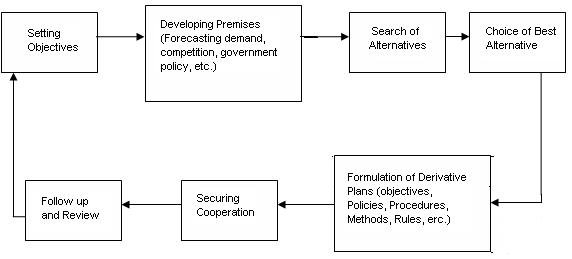Steps In Planning Process
Steps In Planning Process Assignment Help | Steps In Planning Process Homework Help
Steps In Planning Process
The process of planning involves seven steps as shown. These steps are explained below:

1. Setting Objectives. The first step in the planning process is the establishment of objectives which will serve as the basis of planning. As a matter of fact, objectives provide the nucleus to the planning process. They help the employees in understanding what is expected of them.
2. Developing Planning Premises. Planning premises are assumptions about the likely shape of events in the future. They serve as the basis of planning. In order to make effective plans, it is essential that the planning premises are based on systematic forecasting. Assessment of future demand, taste of customers, competition in the market, etc., can be made with the help of forecasting.
3. Search of Alternatives. Search of alternative plans or courses of action is an important step in planning. Generally, there are several alternatives for any problem. The manager should try to screen out the most enviable alternatives so that he has as small number of alternatives for final selection. This will help in the through analysis of the alternatives so developed.
4. Choice of Best Alternative. The alternative generated at the previous stage are evaluated in the light of objectives, costs involved, availability of capital, materials and personnel, etc. The merits and demerits of each alternative are considered. The most beneficial alternative should be chosen and adopted as a plan for the enterprise.
5. Formulation of Derivative Plans. After choosing a particular plan, it is put into practice by the formulation of derivative plans such as policies procedures, schedules, methods, budgets. Derivative plans are the subsidiary plans formulated for various departments, sections or activates in the light of the master plan to help the organization to achieve its objectives in a unified manner. For example, an entrepreneur decides to manufacture refrigerators using Japanese technology. He must formulated derivative plans for procurement of capital, import of technology. location of plant, recruitment of staffed creation of sales and distribution network, etc.
6. Communication of Plans and Securing Cooperation. The plan and the derivative plans should be properly communicated to the lower levels in the organization. It is also significant to secure the cooperation of those concerned with their implementation. The employees should be made to understand the scope and benefits of various plans.
7. Follow up and Review. After the plan has been put into practice, it is essential to follow it up so as to remove difficulties in its implementation. If needed the plan may be modified or revised to achieve the intended objectives.
For more help in Steps In Planning Process click the button below to submit your homework assignment
Step in the process of planning
1. Setting Objectives. The first step in the planning process is the establishment of objectives which will serve as the basis of planning. As a matter of fact, objectives provide the nucleus to the planning process. They help the employees in understanding what is expected of them.
2. Developing Planning Premises. Planning premises are assumptions about the likely shape of events in the future. They serve as the basis of planning. In order to make effective plans, it is essential that the planning premises are based on systematic forecasting. Assessment of future demand, taste of customers, competition in the market, etc., can be made with the help of forecasting.
3. Search of Alternatives. Search of alternative plans or courses of action is an important step in planning. Generally, there are several alternatives for any problem. The manager should try to screen out the most enviable alternatives so that he has as small number of alternatives for final selection. This will help in the through analysis of the alternatives so developed.
4. Choice of Best Alternative. The alternative generated at the previous stage are evaluated in the light of objectives, costs involved, availability of capital, materials and personnel, etc. The merits and demerits of each alternative are considered. The most beneficial alternative should be chosen and adopted as a plan for the enterprise.
5. Formulation of Derivative Plans. After choosing a particular plan, it is put into practice by the formulation of derivative plans such as policies procedures, schedules, methods, budgets. Derivative plans are the subsidiary plans formulated for various departments, sections or activates in the light of the master plan to help the organization to achieve its objectives in a unified manner. For example, an entrepreneur decides to manufacture refrigerators using Japanese technology. He must formulated derivative plans for procurement of capital, import of technology. location of plant, recruitment of staffed creation of sales and distribution network, etc.
6. Communication of Plans and Securing Cooperation. The plan and the derivative plans should be properly communicated to the lower levels in the organization. It is also significant to secure the cooperation of those concerned with their implementation. The employees should be made to understand the scope and benefits of various plans.
7. Follow up and Review. After the plan has been put into practice, it is essential to follow it up so as to remove difficulties in its implementation. If needed the plan may be modified or revised to achieve the intended objectives.
For more help in Steps In Planning Process click the button below to submit your homework assignment